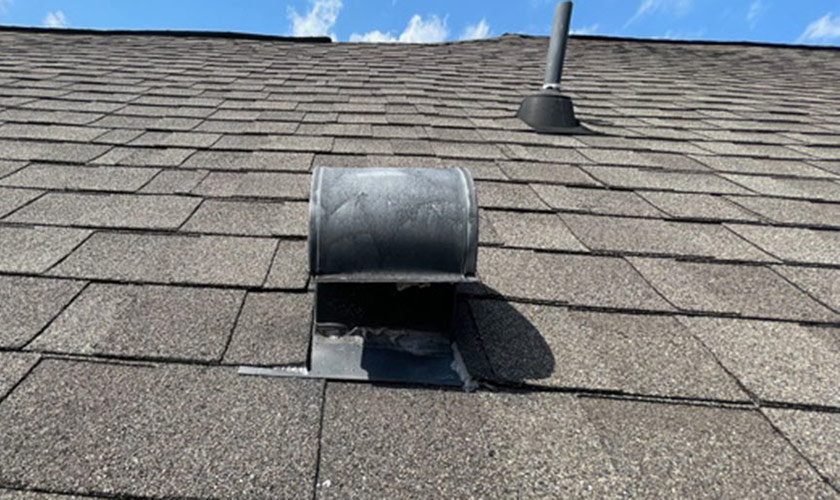
Many homeowners don’t understand what bathroom fans are for. In almost every bathroom, you often find two switches: one for the bathroom light and one for the exhaust fan. But what’s the purpose of the bathroom fan?
A bathroom exhaust fan removes bad smells and excess moisture from your bathroom to the outside. A byproduct of using a bath fan to remove excess moisture is that it controls the growth of mildew, mold, and bacteria, making your bathroom a healthy space.
What are Bathroom Fans For?
An exhaust fan is also called a ventilation fan (or a vent fan for short).
The function of a bathroom fan is to provide a ventilation system for the bathroom to remove water vapor and prevent bacteria, mildew, and mold growth.
Let’s look at each.
Bathroom Fans Work to Remove Excess Moisture
As mentioned, bathroom vent fans remove excess moisture to help maintain good indoor air quality.
High moisture can cause multiple issues within the home, such as poor indoor air quality, microbial growth on surfaces, rust on plumbing fixtures, peeling paint and wallpaper, and warped doors.
High humidity from hot water use causes peeling paint and increases the chances for mold and mildew growth on bathroom walls and ceilings.
Ventless bathroom fans are available when proper ventilation is not possible. However, ventless fans have a charcoal filter that you must replace every 30 days. Ventless fans won’t remove as much moisture as fans venting outside.
Exhaust Fans Remove Smells from the Bathroom
Bathrooms are a place where odors can be hard to control. Without a bathroom fan, bad smells can spread throughout the house.
Bathroom vent fans remove bad smells by drawing odors from the bathroom into the fan and directing them outside. Once the fan turns on, fresh air replaces the smelly air leaving the bathroom through the vent.
If you have a ventless bathroom fan, the activated charcoal filter absorbs and cleans the air before recirculating it back into the bathroom. The more the air circulates, the better the indoor air quality.
How Does a Bathroom Vent Fan Work?
Bathroom ventilation fans use a powerful fan to force the air movement. The amount of air the fan moves is calculated as cubic feet per minute (CFM). The fan draws in the air and then directs it through a duct to the outside.
How are Bathroom Fans Sized?
The CFM rating sizes bathroom vent fans. Therefore, the square footage of the bathroom matters. It’s too small, and the fan won’t move enough air to make a difference.
Most bathroom vent fans come with a CFM rating of 50CFM to 130CFM; however, larger vents are available.
You need the bathroom’s cubic feet to calculate your required CFM fan.
CFM = Ft3 x 0.13
Cubic feet = length x width x height. A bathroom with 9ft length, 6ft wide, and 8ft ceilings would have 432 ft3 (cubic feet of air).
432 x 0.13 = 56.16. You’ll need a bathroom fan with at least a 60CFM rating.
Do Large Bathrooms Need Two Exhaust Fans?
Larger bathrooms need larger or multiple fans to achieve the necessary CFM rating.
It’s common for new construction homes with large bathrooms to have two bathroom fans.
New homes with a large primary bathroom will often have two exhaust fans. Due to building code requirements, a bathroom with a separate toilet room (water closet) will have a dedicated fan.

Is a Bathroom Fan & Exhaust Fan the Same?
Bathroom fans are exhaust fans that are found inside a bathroom. Here are some similar names used for bathroom fans:
- Ventilation fan
- Vent fan
- Ceiling fan
- Wall mount fan
- Exhaust fan
- Extractor fan
So, what is the difference between an exhaust fan and a bathroom fan? Not really.
An exhaust fan’s main job is to create air movement. This can be for a variety of reasons. It mostly gets used in kitchens, bathrooms, and commercial settings.
A bathroom fan is an exhaust fan that uses a powerful fan motor to move moist air from inside to outside.
When Should You Use a Bathroom Fan?
The best time to run a bathroom exhaust fan is during and after your shower to remove steam from your bathroom.
On the other hand, you can use a bathroom fan when using the restroom. The fan helps remove the unpleasant odors so they don’t spread throughout the house. In that case, it might be best to keep the fan on for a few minutes afterward.
If you are forgetful, which many of us are, it is wise to install a timer switch. That way, it is guaranteed to turn off instead of remembering hours later or returning home to a bath fan running.
Should You Run the Fan While Showering?
It is extremely wise to run the bathroom fan on while showering. According to the Home Ventilation Institute (HVI), you should run the exhaust fan roughly 20 minutes after a hot shower.
This removes the excess moisture to keep the bathroom ceiling and walls dry and prevent peeling paint. Since paint can peel off much quicker, mold can quickly grow in unwanted areas.
Mold problems in bathrooms can also lead to structural damage or rotting wood.
If the mold growth is too bad, it can spread into other rooms within your home.
Are Humidity Sensors for Bathroom Fans Worth it?
People often turn off the bathroom fan too quickly after showering. They may be in a hurry or don’t consider the humidity levels inside the bathroom are still too high.
In that case, you might consider getting a humidity sensor fan. A humidity sensor powers the fan on and off to maintain a preset humidity level of your choosing. You can even install a switch with a humidity sensor.
Humidity sensors come in handy by automatically turning the fan on and off as needed, which is handy if you’re in a hurry to leave for work or forget and leave it on.
Should I Leave a Bathroom Fan On?
It is not wise to continuously leave a bathroom fan on, especially overnight. Doing so can lead to a potential fire and other issues at hand.
Although these fans are not the number one cause of house fires, many still occur – and one is one too many.
The US Consumer Products Safety Commission (CPSC) assessed how many fires started from January 1997 to September 2017. They found that 494 fire incidents occurred because of exhaust fans.
More specifically, 75.18% or 318 out of the 494 fires were known specific incidents from bathroom exhaust fans.
There are two main reasons bathroom exhaust fans catch fire:
- Faulty wiring
- The fan is dirty
Bathroom fans collect dust and dirt on the internal housing and fan motor as they work. This debris causes the fan motors to overheat and can even ignite the dust buildup. We recommend cleaning your bathroom fan at least annually.
Dust Buildup Inside the Fan
If you have failed to clean your fan, some hair, dust, debris, or even insects might live inside them.
The buildup eventually becomes too much for the fan or vent duct, leading to a safety hazard. Failing to clean it out also means the fan is useless, so there is no point in turning it on.
Wires Failing on You
An exhaust fan constantly running can lead to numerous problems with the wiring and fan motor.
If you smell plastic burning or hear a sparking noise, this can directly result in the wires malfunctioning. Also, you must immediately turn the fan off.
Make sure to call an electrician right away if this is the case. Sure, you can keep the fan off, but if you have younger children, they may turn it on without you knowing.
If your home is older, contacting a professional for your safety is also a good decision, especially if you are first purchasing a home.
Does the Bathroom Fan Make it Colder?
While a bathroom fan does not cool a room, it can make a bathroom feel colder, especially in winter. When running, the fan removes humid and warm air inside the bathroom, making it feel colder.

Should Bathroom Fans Be Vented Outside?
It is required to have a bathroom fan vented to the outside. Outside venting can occur through a side wall, ducted in the attic space, and then out the roof or soffit.
If your fan vents into an open attic, it can cause moisture to seep in, so make sure you do not vent the fan through a ridge vent or soffit vent.
In some areas, like California, it is required that all exhaust fans in spas or bathrooms with showers and bathtubs must be ENERGY STAR compliant and vented to the outside.
Should Bathroom Fans be Loud? (Sone Ratings)
Quiet bathroom fans are preferable because they are less distracting, especially if you like to listen to music or watch videos while getting ready for work. Having a noisy bathroom fan can be relatively irritable, especially if you go into a spa or your bathroom is made to be quite relaxing.
Sound level is measured in decibels. However, you won’t see a decibel level on the packaging. You will want to look at the Sone rating for a bathroom fan.
The higher the Sone rating, the noisier the fan will be. Since you most likely want a quiet sound rating fan, you will want to look into 1.5 or below. The softest bathroom fans are 0.5 sones and down, whereas a loud noise level would be at a 4.0 rating.
Given that information, it is not required for a bathroom fixture to be loud. The lower the sone rating, the quieter the bathroom fan.
Bathroom Fan FAQs
In addition to understanding what bathroom fans are for, here are some more frequently asked questions.
Do bathroom fans have heaters?
Some bathroom fans have heaters, which is helpful in bathrooms without a heat source. These built-in heaters are electric heat strips and are not energy-efficient to operate, so avoid running them when it’s not necessary.
How long should a bathroom fan run?
Factors like the bathroom size, the number of people using the bathroom, and the humidity levels are all important to consider. A good rule of thumb is to run the fan for at least 20 minutes after a shower or bath. This will help remove all the air’s moisture and keep your bathroom fresh and dry.
Do bathroom fans remove heat?
Bathroom fans do not remove heat from the air, but they can help circulate the air and make the room feel cooler. If your bathroom is feeling stuffy, running the fan for a few minutes will help freshen the air.
Where does the air go from a bathroom fan?
If installed correctly, the air from a bathroom fan is expelled outside of the home. This helps to keep the air in your bathroom clean and fresh and prevents mold and mildew from growing.
Is it okay to leave a fan on all night?
Many people turn their bathroom fans on for the white noise at night. You shouldn’t leave a bathroom fan running all night. The longer a bathroom fan runs, the more likely the fan motor can overheat and potentially start a fire.







